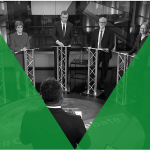
Dr Nick Anstead
Associate Professor at the Department of Media and Communications at the LSE. His research focuses on political communication and election campaigning. Nick is a Fellow of the Royal Society of the Arts, a frequent political commentator on national and international media.
Email: n.m.anstead@lse.ac.uk
Twitter: @nickanstead

Section 7: News and Journalism
- What was all that about, then? The media agenda in the 2019 General Election
- Pluralism or partisanship? Calibrating punditry on BBC2’s Politics Live
- Hero and villain: the media’s role in identity management
- Traditional majoritarian conceptions of UK politics pose a dilemma for the media in elections
- #GE2019: A tale of two elections?
- Boxing clever: negotiating gender in campaign coverage during the 2019 General Election
- Press distortion of public opinion polling: what can, or should, be done?
- The final verdict: patterns of press partisanship
- The class war election
- An uncertain future for alternative online media?
Even in an election campaign were few individuals or institutions emerged with credit, the organisation of televised debates was particularly shambolic.
To recap, the centrepieces of the debate schedule were two head-to-head leaders’ debates featuring Boris Johnson and Jeremy Corbyn. Additionally, there were a smorgasbord of other programmes including seven-way leaders’ debates (which Johnson and Corbyn did not attend, instead sending party representatives); party leader-focused editions of Question Time; policy-focused debates on issues such as climate change; and programmes for Scotland, Wales and Northern Ireland.
The 2019 debate schedule proved that quantity does not guarantee quality. Nor does novelty. While the two head-to-head leaders’ debates were a first for a UK election, the content of the programmes was largely limited to pre-prepared talking points. Furthermore, the two-way debates ran the risk of distorting the electoral playing field, neglecting the decisions that faced voters in constituencies which were not a straight contest between the Conservatives and Labour.
How did we end up in this situation? Debates in the UK are not regulated but rather negotiated by self-interested political parties and broadcasters on ad hoc basis each time the country goes to the polls. Hence the changing formats over the years – the three-party debates of 2010, the seven-party debate of 2015, the absence of meaningful debates in 2017, and now the two-party debates of 2019.
This creates a huge problem, as it means the rules for debate inclusion are non-transparent. To ask a counterfactual question, in a parallel universe where Liberal Democrat support had surged during the election campaign, what poll numbers would Jo Swinson have required to be invited to attend the ITV and BBC debates? We have no idea because the broadcasters never developed criteria for inclusion (or if they did, they never revealed them).
Additionally, over the course of recent elections, the way broadcasters are negotiating debates has changed. In 2010, the programmes were the product of broadcasters acting as a consortium. This is why each organisation (the BBC, ITV and Sky) got to lead on one of the three programmes. Now there appears to be far greater competition between broadcasters. Indeed, Sky admitted as much when it pitched for a three-way debate. Their original plan had been for a debate between Johnson and Corbyn, but since ITV had got agreement for this format first, Sky modified their proposal. Needless to say, because it did not suit the agenda of the two major parties, the Sky debate never happened. Competition among broadcasters of this kind is a real problem, as it means politicians (particularly those from the larger parties) can play them off against each other to get their preferred formats.
The Channel 4 climate change debate highlighted other problems. This was attended by five party leaders. Boris Johnson and Nigel Farage did not accept the invitation from the broadcasters. Instead, they were replaced by blocks of ice on the debate stage. On the night of the debate, Conservative Minister Michael Gove arrived at the studio and demanded to be included in the debate. This request was refused by Channel 4, on the grounds that the debate was for party leaders.
While Gove’s actions were clearly grandstanding, designed to create a story for social media, this event raises a question about why Channel 4 felt a leaders’ debate was an appropriate format to discuss climate change. After all parties have environment ministers and spokespeople charged with the environment brief. If we are generous, we can say Channel 4’s decision is the product of the UK’s dysfunctional system of cabinet government which has become overly presidentialised. Less charitably, we might say that the network felt party leaders would get higher ratings.
We urgently need to look overseas at other parliamentary democracies for better ways to organise election debates. Canada is a Westminster-style Parliamentary democracy with a multi-party system including strong regional parties, which has held election debates since 1968. Perhaps the most important lesson the UK could learn from Canada comes from the creation of the Independent Leaders’ Debate Commission in 2018 (prior to this, debates had been organised by a consortium of broadcasters, although even then the rules for organisation were considerably more advanced and transparent than anything in the UK). The Commission organised the two debates in the 2019 election campaign, applying very clear rules for inclusion, which are laid out in the Order of Council that created it.
For the avoidance of doubt: TV debates are a good innovation, with the potential to enhance the election campaign for voters and help them make informed choices. But this makes it even more important they are not created through shoddy backroom deals between politicians and broadcasters. It is time for the UK to get serious about TV debates.
